》两个英译本比较看翻译的文化转向
- 格式:pdf
- 大小:241.89 KB
- 文档页数:6
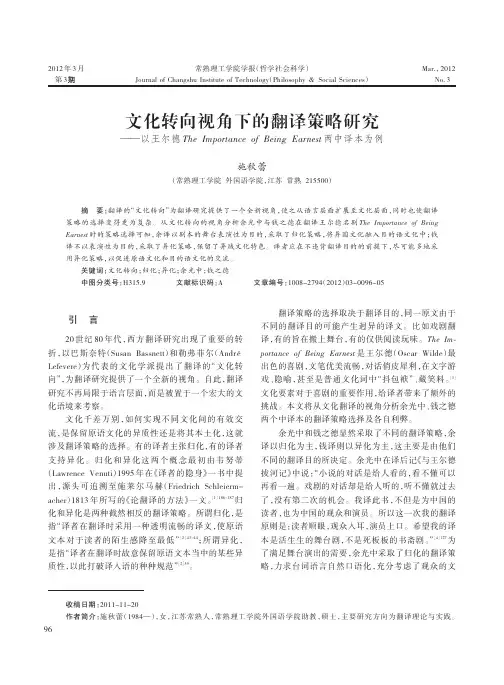
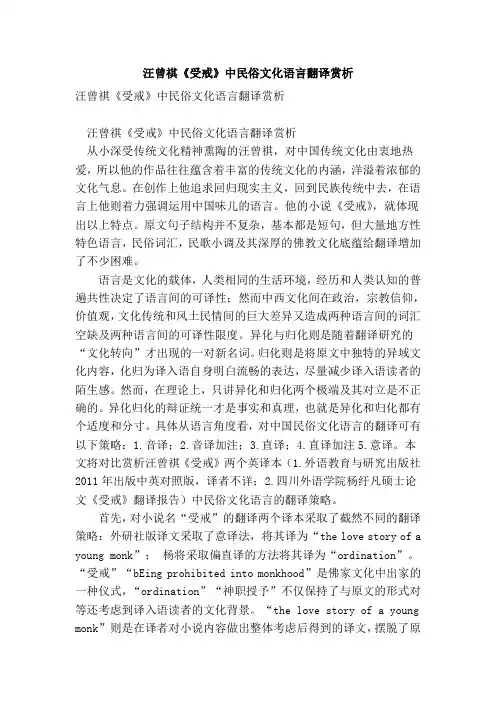
汪曾祺《受戒》中民俗文化语言翻译赏析汪曾祺《受戒》中民俗文化语言翻译赏析汪曾祺《受戒》中民俗文化语言翻译赏析从小深受传统文化精神熏陶的汪曾祺,对中国传统文化由衷地热爱,所以他的作品往往蕴含着丰富的传统文化的内涵,洋溢着浓郁的文化气息。
在创作上他追求回归现实主义,回到民族传统中去,在语言上他则着力强调运用中国味儿的语言。
他的小说《受戒》,就体现出以上特点。
原文句子结构并不复杂,基本都是短句,但大量地方性特色语言,民俗词汇,民歌小调及其深厚的佛教文化底蕴给翻译增加了不少困难。
语言是文化的载体,人类相同的生活环境,经历和人类认知的普遍共性决定了语言间的可译性;然而中西文化间在政治,宗教信仰,价值观,文化传统和风土民情间的巨大差异又造成两种语言间的词汇空缺及两种语言间的可译性限度。
异化与归化则是随着翻译研究的“文化转向”才出现的一对新名词。
归化则是将原文中独特的异域文化内容,化归为译入语自身明白流畅的表达,尽量减少译入语读者的陌生感。
然而,在理论上,只讲异化和归化两个极端及其对立是不正确的。
异化归化的辩证统一才是事实和真理,也就是异化和归化都有个适度和分寸。
具体从语言角度看,对中国民俗文化语言的翻译可有以下策略:1.音译;2.音译加注;3.直译;4.直译加注5.意译。
本文将对比赏析汪曾祺《受戒》两个英译本(1.外语教育与研究出版社2011年出版中英对照版,译者不详;2.四川外语学院杨纡凡硕士论文《受戒》翻译报告)中民俗文化语言的翻译策略。
首先,对小说名“受戒”的翻译两个译本采取了截然不同的翻译策略:外研社版译文采取了意译法,将其译为“the love story of a young monk”;杨将采取偏直译的方法将其译为“ordination”。
“受戒”“bEing prohibited into monkhood”是佛家文化中出家的一种仪式,“ordination”“神职授予”不仅保持了与原文的形式对等还考虑到译入语读者的文化背景。
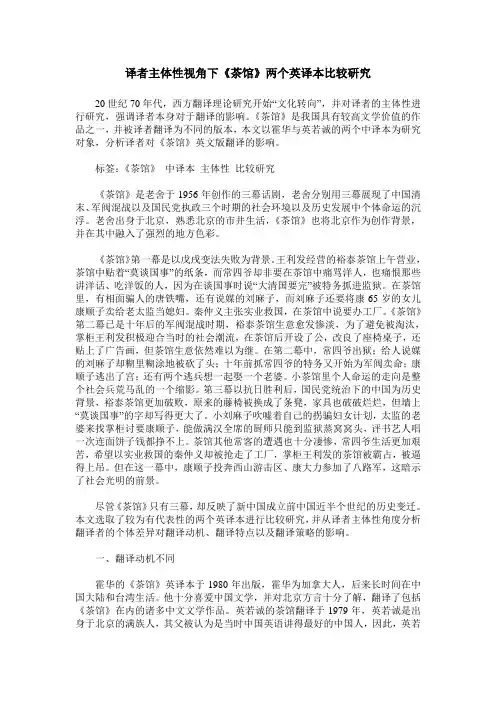
译者主体性视角下《茶馆》两个英译本比较研究20世纪70年代,西方翻译理论研究开始“文化转向”,并对译者的主体性进行研究,强调译者本身对于翻译的影响。
《茶馆》是我国具有较高文学价值的作品之一,并被译者翻译为不同的版本,本文以霍华与英若诚的两个中译本为研究对象,分析译者对《茶馆》英文版翻译的影响。
标签:《茶馆》中译本主体性比较研究《茶馆》是老舍于1956年创作的三幕话剧,老舍分别用三幕展现了中国清末、军阀混战以及国民党执政三个时期的社会环境以及历史发展中个体命运的沉浮。
老舍出身于北京,熟悉北京的市井生活,《茶馆》也将北京作为创作背景,并在其中融入了强烈的地方色彩。
《茶馆》第一幕是以戊戌变法失败为背景。
王利发经营的裕泰茶馆上午营业,茶馆中贴着“莫谈国事”的纸条,而常四爷却非要在茶馆中痛骂洋人,也痛恨那些讲洋话、吃洋饭的人,因为在谈国事时说“大清国要完”被特务抓进监狱。
在茶馆里,有相面骗人的唐铁嘴,还有说媒的刘麻子,而刘麻子还要将康65岁的女儿康顺子卖给老太监当媳妇。
秦仲义主张实业救国,在茶馆中说要办工厂。
《茶馆》第二幕已是十年后的军阀混战时期,裕泰茶馆生意愈发惨淡,为了避免被淘汰,掌柜王利发积极迎合当时的社会潮流,在茶馆后开设了公,改良了座椅桌子,还贴上了广告画,但茶馆生意依然难以为继。
在第二幕中,常四爷出狱;给人说媒的刘麻子却糊里糊涂地被砍了头;十年前抓常四爷的特务又开始为军阀卖命;康顺子逃出了宫;还有两个逃兵想一起娶一个老婆。
小茶馆里个人命运的走向是整个社会兵荒马乱的一个缩影。
第三幕以抗日胜利后,国民党统治下的中国为历史背景,裕泰茶馆更加破败,原来的藤椅被换成了条凳,家具也破破烂烂,但墙上“莫谈国事”的字却写得更大了。
小刘麻子吹嘘着自己的拐骗妇女计划,太监的老婆来找掌柜讨要康顺子,能做满汉全席的厨师只能到监狱蒸窝窝头,评书艺人唱一次连面饼子钱都挣不上。
茶馆其他常客的遭遇也十分凄惨,常四爷生活更加艰苦,希望以实业救国的秦仲义却被抢走了工厂,掌柜王利发的茶馆被霸占,被逼得上吊。
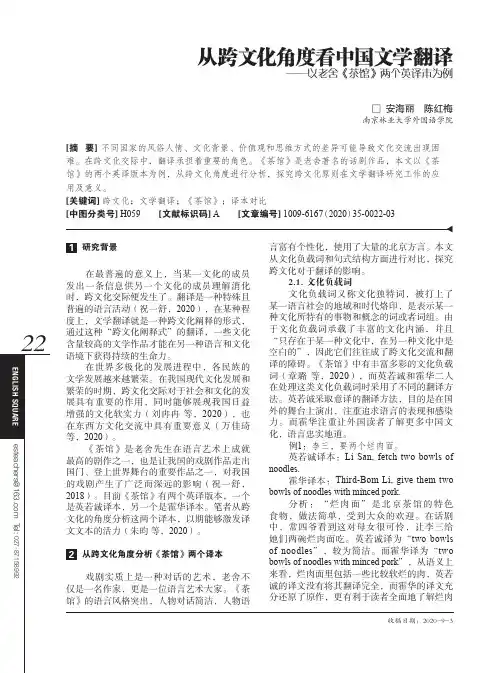
收稿日期:2020-9-31 研究背景在最普遍的意义上,当某一文化的成员发出一条信息供另一个文化的成员理解消化时,跨文化交际便发生了。
翻译是一种特殊且普遍的语言活动(祝一舒,2020),在某种程度上,文学翻译就是一种跨文化阐释的形式,通过这种“跨文化阐释式”的翻译,一些文化含量较高的文学作品才能在另一种语言和文化语境下获得持续的生命力。
在世界多极化的发展进程中,各民族的文学发展越来越繁荣。
在我国现代文化发展和繁荣的时期,跨文化交际对于社会和文化的发展具有重要的作用,同时能够展现我国日益增强的文化软实力(刘冉冉 等,2020),也在东西方文化交流中具有重要意义(万佳琦 等,2020)。
《茶馆》是老舍先生在语言艺术上成就最高的剧作之一,也是让我国的戏剧作品走出国门、登上世界舞台的重要作品之一,对我国的戏剧产生了广泛而深远的影响(祝一舒,2018)。
目前《茶馆》有两个英译版本,一个是英若诚译本,另一个是霍华译本。
笔者从跨文化的角度分析这两个译本,以期能够激发译文文本的活力(朱昀 等,2020)。
2 从跨文化角度分析《茶馆》两个译本戏剧实质上是一种对话的艺术,老舍不仅是一名作家,更是一位语言艺术大家。
《茶馆》的语言风格突出,人物对话简洁,人物语言富有个性化,使用了大量的北京方言。
本文从文化负载词和句式结构方面进行对比,探究跨文化对于翻译的影响。
2.1. 文化负载词文化负载词又称文化独特词,被打上了某一语言社会的地域和时代烙印,是表示某一种文化所特有的事物和概念的词或者词组。
由于文化负载词承载了丰富的文化内涵,并且“只存在于某一种文化中,在另一种文化中是空白的”,因此它们往往成了跨文化交流和翻译的障碍。
《茶馆》中有丰富多彩的文化负载词(章璐 等,2020),而英若诚和霍华二人在处理这类文化负载词时采用了不同的翻译方法。
英若诚采取意译的翻译方法,目的是在国外的舞台上演出,注重追求语言的表现和感染力。
而霍华注重让外国读者了解更多中国文化,语言忠实地道。
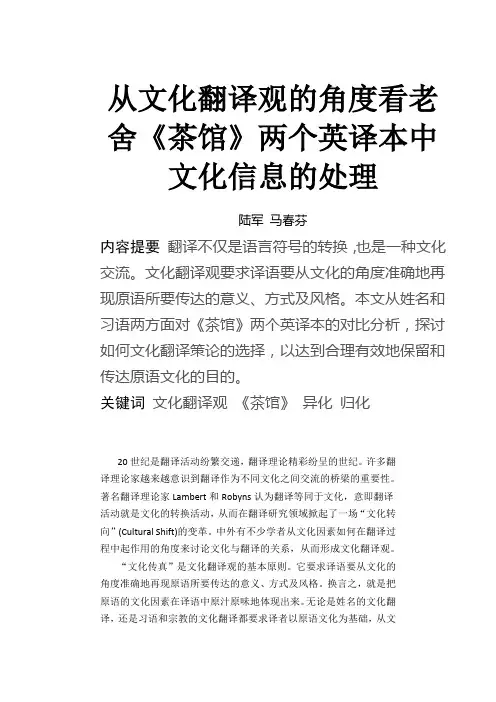
从文化翻译观的角度看老舍《茶馆》两个英译本中文化信息的处理陆军马春芬内容提要翻译不仅是语言符号的转换,也是一种文化交流。
文化翻译观要求译语要从文化的角度准确地再现原语所要传达的意义、方式及风格。
本文从姓名和习语两方面对《茶馆》两个英译本的对比分析,探讨如何文化翻译策论的选择,以达到合理有效地保留和传达原语文化的目的。
关键词文化翻译观《茶馆》异化归化20世纪是翻译活动纷繁交递,翻译理论精彩纷呈的世纪。
许多翻译理论家越来越意识到翻译作为不同文化之间交流的桥梁的重要性。
著名翻译理论家Lambert和Robyns认为翻译等同于文化,意即翻译活动就是文化的转换活动,从而在翻译研究领域掀起了一场“文化转向”(Cultural Shift)的变革。
中外有不少学者从文化因素如何在翻译过程中起作用的角度来讨论文化与翻译的关系,从而形成文化翻译观。
“文化传真”是文化翻译观的基本原则。
它要求译语要从文化的角度准确地再现原语所要传达的意义、方式及风格。
换言之,就是把原语的文化因素在译语中原汁原味地体现出来。
无论是姓名的文化翻译,还是习语和宗教的文化翻译都要求译者以原语文化为基础,从文化翻译观的角度选择适当的翻译策略,准确传达原语的文化,达到“文化传真”的目的。
老舍的《茶馆》是中国当代话剧艺术的经典之作。
戏剧中塑造了具有时代特征、中国特色的人物群像,里面蕴藏着丰富的文化信息并包含了大量的文化特征和文化背景,带有浓厚的民族特色和地域色彩。
霍华和英若诚先后翻译了《茶馆》这部伟大的戏剧。
本文以《茶馆》的这两个英译本为例,从姓名和习语文化两方面谈谈如何合理有效地保留和传达原语文化。
一、姓名称谓的文化翻译文学作品中离不开人物描写,有人物就离不开姓名称谓,否则就无以标志,无法区别。
姓名称谓是特定文化的产物,是人际关系的文化符号。
它是人类社会中体现特定的人在特定的人际关系中的身份角色的称呼,它反映着一定社会文化或特定语言环境中人与人之间的关系。
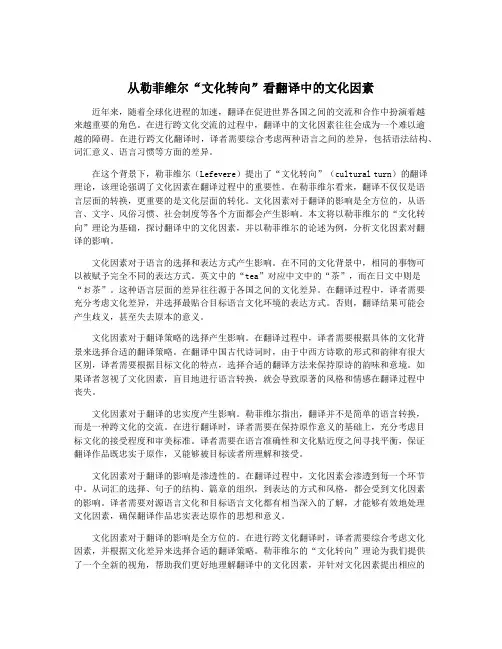
从勒菲维尔“文化转向”看翻译中的文化因素近年来,随着全球化进程的加速,翻译在促进世界各国之间的交流和合作中扮演着越来越重要的角色。
在进行跨文化交流的过程中,翻译中的文化因素往往会成为一个难以逾越的障碍。
在进行跨文化翻译时,译者需要综合考虑两种语言之间的差异,包括语法结构、词汇意义、语言习惯等方面的差异。
在这个背景下,勒菲维尔(Lefevere)提出了“文化转向”(cultural turn)的翻译理论,该理论强调了文化因素在翻译过程中的重要性。
在勒菲维尔看来,翻译不仅仅是语言层面的转换,更重要的是文化层面的转化。
文化因素对于翻译的影响是全方位的,从语言、文字、风俗习惯、社会制度等各个方面都会产生影响。
本文将以勒菲维尔的“文化转向”理论为基础,探讨翻译中的文化因素,并以勒菲维尔的论述为例,分析文化因素对翻译的影响。
文化因素对于语言的选择和表达方式产生影响。
在不同的文化背景中,相同的事物可以被赋予完全不同的表达方式。
英文中的“tea”对应中文中的“茶”,而在日文中则是“お茶”。
这种语言层面的差异往往源于各国之间的文化差异。
在翻译过程中,译者需要充分考虑文化差异,并选择最贴合目标语言文化环境的表达方式。
否则,翻译结果可能会产生歧义,甚至失去原本的意义。
文化因素对于翻译策略的选择产生影响。
在翻译过程中,译者需要根据具体的文化背景来选择合适的翻译策略。
在翻译中国古代诗词时,由于中西方诗歌的形式和韵律有很大区别,译者需要根据目标文化的特点,选择合适的翻译方法来保持原诗的韵味和意境。
如果译者忽视了文化因素,盲目地进行语言转换,就会导致原著的风格和情感在翻译过程中丧失。
文化因素对于翻译的忠实度产生影响。
勒菲维尔指出,翻译并不是简单的语言转换,而是一种跨文化的交流。
在进行翻译时,译者需要在保持原作意义的基础上,充分考虑目标文化的接受程度和审美标准。
译者需要在语言准确性和文化贴近度之间寻找平衡,保证翻译作品既忠实于原作,又能够被目标读者所理解和接受。
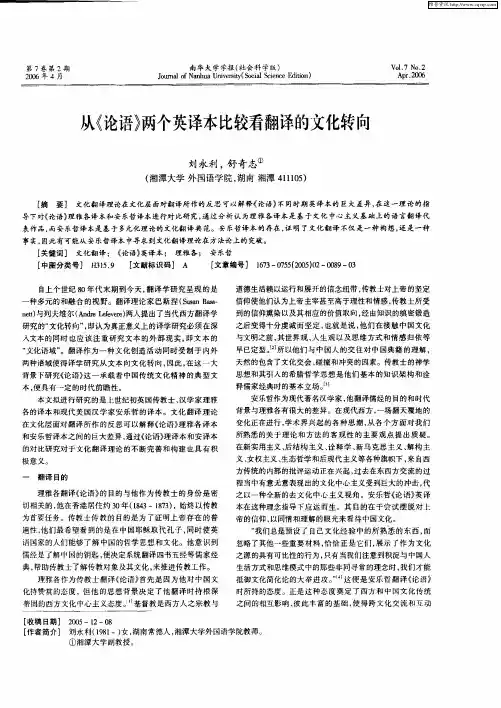
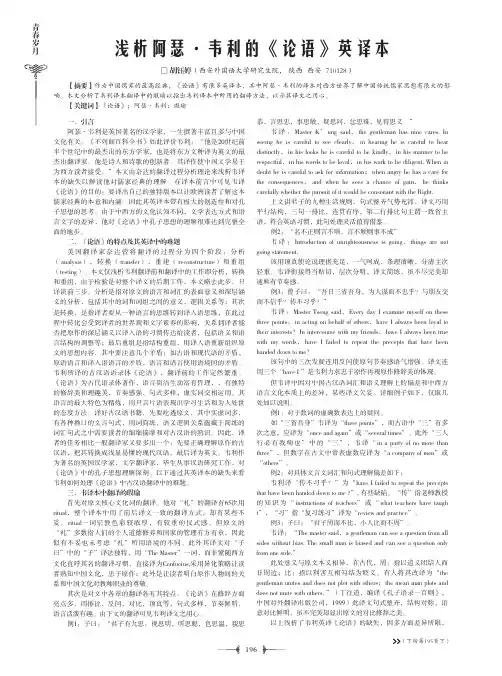
青春岁月一、引言恭,言思忠,事思敏,疑思问,忿思难,见得思义。
”阿瑟韦利是英国著名的汉学家,一生撰著丰富且多与中国韦译:Master K’ung said,the gentleman has nine cares. In 文化有关。
《不列颠百科全书》如此评价韦利:“他是20世纪前seeing he is careful to see clearly,in hearing he is careful to hear 半个世纪中的最杰出的东方学家,也是将东方文种译为英文的最distinctly,in his looks he is careful to be kindly,in his manner to be 杰出翻译家。
他是诗人和诗歌的创新者。
其译作使中国文学易于respectful,in his words to be loyal,in his work to be diligent. When in 为西方读者接受。
”本文由奈达的翻译过程分析理论来浅析韦译doubt he is careful to ask for information;when angry he has a care for 本的缺失以解读他对儒家经典的理解。
在译本前言中可见韦译the consequences,and when he sees a chance of gain,he thinks 《论语》的目的:要译出自己的独特版本以让欧洲读者了解这本carefully whether the pursuit of it would be consonant with the Right.儒家经典的本意和内涵。
因此其英译本带有极大的创造性和对孔上文讲君子的九种生活规则,句式整齐气势充沛,译文巧用子思想的思考。
由于中西方的文化认知不同,文学表达方式和语平行结构,三句一排比,连贯有序,第二行排比句主谓一致省主言文字的差异,他对《论语》中孔子思想的理解很难达到完整全语,符合英语习惯,此句处理灵活值得借鉴。
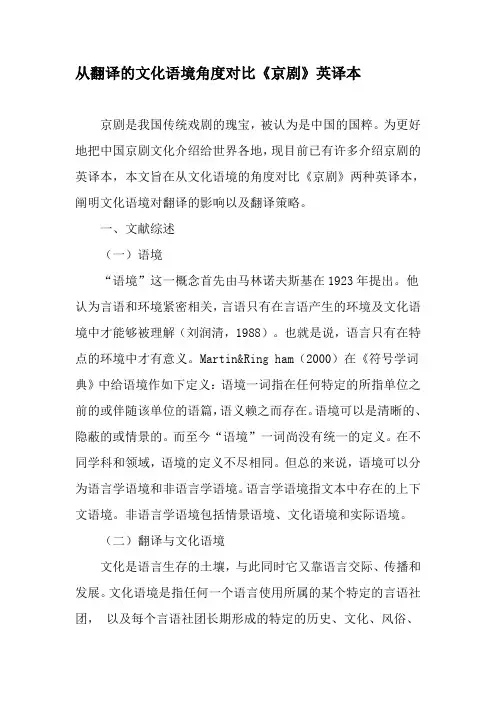
从翻译的文化语境角度对比《京剧》英译本京剧是我国传统戏剧的瑰宝,被认为是中国的国粹。
为更好地把中国京剧文化介绍给世界各地,现目前已有许多介绍京剧的英译本,本文旨在从文化语境的角度对比《京剧》两种英译本,阐明文化语境对翻译的影响以及翻译策略。
一、文献综述(一)语境“语境”这一概念首先由马林诺夫斯基在1923年提出。
他认为言语和环境紧密相关,言语只有在言语产生的环境及文化语境中才能够被理解(刘润清,1988)。
也就是说,语言只有在特点的环境中才有意义。
Martin&Ring ham(2000)在《符号学词典》中给语境作如下定义:语境一词指在任何特定的所指单位之前的或伴随该单位的语篇,语义赖之而存在。
语境可以是清晰的、隐蔽的或情景的。
而至今“语境”一词尚没有统一的定义。
在不同学科和领域,语境的定义不尽相同。
但总的来说,语境可以分为语言学语境和非语言学语境。
语言学语境指文本中存在的上下文语境。
非语言学语境包括情景语境、文化语境和实际语境。
(二)翻译与文化语境文化是语言生存的土壤,与此同时它又靠语言交际、传播和发展。
文化语境是指任何一个语言使用所属的某个特定的言语社团,以及每个言语社团长期形成的特定的历史、文化、风俗、习俗、价值标准和思维方式等。
由于不同民族所处的自然地理、人文历史和文化环境不同,各民族的人们对外部世界反映产生的印象和概念也会出现差异,所以不同语言文化在历史传统、价值取向、风俗习惯、宗教信仰、思维方式及地理环境等方面的差异会使同一词语在不同文化语境中产生不同的喻义,引起的情感也往往因文化不同而各异。
在交际过程中,语言的意义通常是根据语境来确定的(张美芳,2002)。
奈达认为翻译是语言交际活动,它取决于听/读者从译文中所获得的信息。
马林诺夫斯基认为不同的文化背景是语言翻译障碍的最主要因素,语言不是一套完备的体系,语言中的意义不可能由它自己本身来描写,而是由语境来决定的(俞如珍、金顺德,1997)。
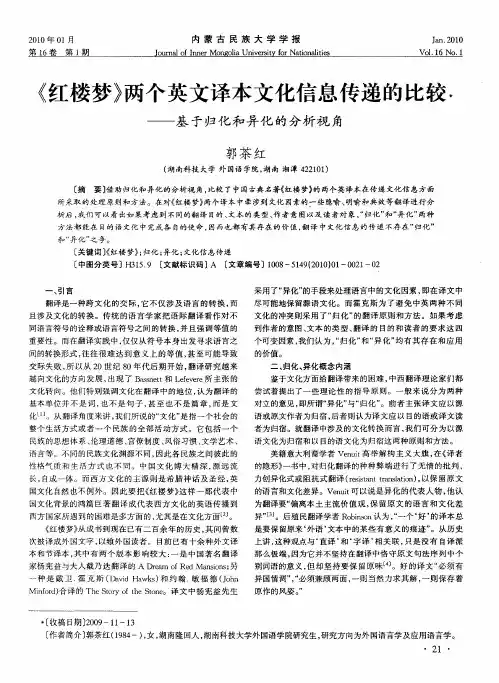

摘要:本文通过比较“红楼梦”二个英文全译本,讨论了文化差异对翻译实践的影响,认为译者母语的文化背景差异导致了二个译本之间以及与原文的差异,即翻译受到译者意识形态的无形制约.从跨文化研究角度看《, 红楼梦》某些涵盖文化内容的翻译所出现的问题可以通过脚注或专注,使之既凸现原文的文化内涵,又保持行文流畅.关键词:文化差异;翻译;红楼梦1IntroductionThe Chinese classical novel Hongloumeng has been translated into more than twenty languages with over one hundred translation versions. Out of its six English translation versions, four are translations of selected chapters, two are complete versions. The Story of the Stone is a complete translation in five volumes. Its first three vol2 umes were translated by David Hawkes published in 1973 , 1977 and 1980 respectively , while the fourth and fifth volumes , containing the last forty chapters , were translated by John Minford , the son2in2law of David Hawkes’s , and they were published in 1982 and 1986 by Penguin Books Ltd , Harmonsworth , Middlesex ,England. A Dream of Red Mansions is another complete English version in three volumes translated by Yang Hsien - Yi and Gladys Yang. They were published by Foreignlan2 guages Press, Beijing, China, 1978. These two versions are the most popular English versions and remain to be the only two complete translations as well. Traditionally, translation has been described as comparative linguistic undertaking, wherefore translation has been tackled primarily from the perspective of the differences in language structures. However, this comparative linguistic appraochcould hardly explain the complex phenomenon of translation because inter - lingualcommunication stretches far beyond the mechanics of linguistic similarities andcontrasts just as Nida says :“the meaning of verbal symbols on any and every leveldepends on the culture of language community ,”and“language constitutes a model ofthe culture. ”(C hristine Schuffner & Helen Kelly Holms 1995 : 1)This paper argues that translation is not merely a matter of selecting felicitouse quivalent words, but it is a matter of making intelligible a whole culture. By citing examples with respect to cultural contexts, this paper also reveals that translation is a kind of intercultural exchange , which bridges up the “gap ”or“distance” between two different kinds of cultures.2 Cultural differences as manifested in the two different translations of Hongloumeng2. 1 Mode of thoughtThought patterns vary as cultures differ from one an2 other. According to the diagramfrom Robert B. Kaplan, “Cultural Thought Patterns in Inter - cultural Educa tion”, an English paragraph, which normally follows a straight line of development, is very different from an Oriental paragraph, which tends to follow a circular line of development. In this sense, putting Chinese into English is a matter of how to arrange words together in a sentence because the words and word groups of one language don’t fit together in the same way as the words of another language do. That means each culture has its own special way of thinking. Apart from this, the same words and symbols on many occasions create different images in the mind of people with different culture , or rather , one’s mode of thought could hardly separate from his culture.(1)“你妹妹远路才来,身子又弱,也才劝住了, 快别再提了. ”[第三回P30 ]’So don’t reopen that subject .[ Trans , TheYangs V ol . I P39 ]’So let’s have no more of this.[ Trans. Hawkes V ol . I , P92 ]It is interesting to find that the structure of Professor Yang’s translation is similar to the structure of the original Chinese, which is subject - matter prominent, while Professor Hawkes’translation is consistent with the English way of arranging word order. The addition of words “Let’s” indicates, unlike Chinese, English is a subject prominent language. By domesticating the form of language, Hawkes has made the rendering more readable and comprehensible to the English readers and meanwhile retains the original stylistic color.(2)“Take renditions of“东风”from Bao Yu’s“怡红快绿”for another example :’对立东风里, 主人应解怜. ’[第十八回P211 ]’Facing each other in the soft east wind.[ Trans. TheYangs V ol . I , P261 ]’Their mistress , standing in the soft summer breeze.[ Trans. Hawkes V ol . I , P370 ]“东风”is a word with Chinese cultural flavor. It is literally translated into “east wind” by Professor Yang, and freely rendered into “summer breeze” by Professor Hawkes. This indicates each of them looked at the text in quite a different way , and therefore applied different methods to the translation practice : Professor Yang’s is semantic translation focusing primarily upon the semanticcontent of the source text and Professor hawkes’communicative translation focusing essentially upon the comprehension and response of receptors. Owing to the differ2 ence of geographical position some of the words carry dif2 ferent conceptualmeaning : in Chinese classic Qu’s and Ci’s ,“东风”refers to“spring breeze”Take the lines from“The Romance of Western Bower”(西厢记) written by Wang Shifu( (元)王实甫) for example“, 可正是人值残春蒲郡东,门掩重关萧寺中;花落水流红,闲愁万种,无语笑东风. ”(1996 : 2) In this discourse ,we are here in late spring , so it gives hint for people to recognize that the Chinese“east wind”actually refers to the“spring wind”. But what for the“east wind”in the mind of English peo2 ple ?Dickens wrote in one of his novels :“How many win2 ter days have I seen him , standing blue - nosed in thes2 now and east wind !”(钱哥川1981 : 31) This shows “east wind”in English isassociated with winter , and is often modified by such words as keen , biting and pierc2 ing. Considering the cultural factor and readership , Pro2 fessor Hawkes put“东风”into English“summer breeze”to bridge up the culture difference , forliteral translation without annotation would be misleading.2. 2 ValuesValues are overt expressions of what is considered good or evil , beautiful orugly , and right or wrong. They are standards by which we judge the actions andpositions of ourselves and others. ( Gail B. Ellenbaum & Charles O. Ellenbaum1992 : 37) Individuals in each culture may not accept the same set of values ,and they may express their values differently. As each language reflects andcre2 ates cultural attitudes , each has a unique way of express2 ing values.(3)“贾母王夫人等因素喜李纨贤惠, 且年轻守节, 令人敬服, 今见他寡婶来了,便不肯叫他外头去住. 那婶母虽十分不肯,无奈贾母执意不从,只得带着李纹李绮在稻香村住下了. ”[第四十九回P607 ]’Because the Lady Dowager and Lady Wang appre2 ciated Li Wan’s good qualities and her admirable conduct since her husband’s unt imely death , they would not hear ofher widowed aunt staying anywhere but in their house. So although most reluctant toimpose on them , on the old lady’s insistence Li Wan’s aunt had to move into Paddy - Sweet Cottage with her two daughters. ’[ Trans. TheYangs V ol . II , P128 ]’Grandmother Jia and Lady Wang esteemed Li Wan as a good and virtuous young woman who , having lost her husband at an early age , bore widowhood with fortitude andrestraint. Now that this widowed aunt had arrived , they refused to hear of hertaking lodgings outside , and though the good lady made many polite efforts to decline , insisted that she and her two daughters , Li Wen and Li Qi , should move into Sweet - rice Village and stay there with Li Wan at the family’s expense. ’[ Trans. Hawkes V ol . II. P473 ]Differences between the two translations of“. . . 只得带着李纹李绮在稻香村住下了. ”lie in the aspect of way of thinking. Following the original text, Prof. Yang’s literal translation reveals the politeness and indirectness of Chinese discourse habit and a kind of Chinese national psychology that is avoiding talking about money, which dates from ancient time. Prof. Hawkes’s communicative translation, or rather adding cultural words “stay there with Li Wan at the family’s expense” i ndicates westerners’value orientation. That is money is a powerful thing. They talk about and admire it more openly. For in2 stance, Americans regard money “as a measure of suc cess , and the final guarantee of personal choice. ”(Jane Walmsley2002 : 7) Even between full brothers they will make out bills clearly. This kind of providing background information explains the reason why Grandmother Jia insisted LiWan’s aunt’s staying at Li Wan’s place, and why Li Wan’s widowed aunt was reluctant to stay there. In a word, translation is invisibly restri cted or influenced by ideology.2. 3 Tradition , customs and life style(4) Dining“两边靠门一小桌: 李纨和凤姐,虚设座位,两人皆不敢坐,只在贾母王夫人两桌上伺候. ”[第三十八回P461 - 462 ]“. . . and the small one near the door on the west for Li Wan and His - feng. The seatsat this were unoccu2 pied , however , as they were waiting on the tables of the LadyDowager and Lady Wang. ”[ Trans. The Yangs Vol . I , P461 ]“A little table was laid for Xi - feng and Li - Wan on the west side , of the doorway , but this was only for form’s sake , since both of them remained on th eir feet inorder to wait on the other two tables.[Trans. Hawke V ol . II ,P243]Though both of the translation versions are faithful, Prof. Hawkes’s translation sounds more interesting and expressive. In his translation the cultural words“虚设座位”was turned into“this was only for form’s sake”, and leaves us an impression that Hawkes’s mastery of Chinese is indeed remarkable. It is true in the Hongloumeng when Jia family gave a dinner party; the guests usually sit around as quare table. The respectable one sat at the head of the table with two people sitting on each side. And at the other end of the table no seat is set there for the sake of serving the food according to the Customs of A Dream of Red Mansions (《红楼梦风俗谭》.(5) Ritual of initiation “既要学做诗,你就拜我为师. ”[第四十八回P597 ]“If you want to write poetry you must acknowledge me as your tutor. ”[ Trans. The Yangs V ol . II. P115 ]“You can make your kotow and become my pupil if you like. ”[ Trans. Hawkes V ol . II , P456 ] As an old custom in the past ,“拜师”means mak ing actual kowtow to one’s teacher. Hawkes reveals the his2 torical background to the target readers through histransla2 tion while Prof. Yang’s version gives us a flavor of modern sense which seems not quite go hand in hand with the original .3 Bridging up cultural differences in translation3. 1 TransliterationIn cross - cultural communication, transliteration , which implies the writing of words with characters of an2 other alphabet that represent the same sound or sounds , is one of the most essential way to achieve the source language country’s cultural fidelity.According to the great translator of Buddhist scripture, Xuan Zhuang(600 - 664) ,transliteration can be applied in the following cases , such as incantation ,polysemia , terms to SL country , already accepted translation and on some needed occasions of Buddhism. ( 陈福康1992 ;42) . Apart from this theory, pointed out :“Transcription is mandatory in all the following cases , unless there is already a generally accepted translation likely to be accessible and acceptable to the reader : (a) proper nouns - particularly names of people (except the Pope) and of geographical features ; (b) ad2 dresses (c) names of private firms (d) names of national public and private institutions , unless they are transparent ; (e) terms peculiar to the institutions , ecology and general culture of the SL countries , where there are no equivalents in the TL countries and (f ) titles of newspapers ,periodicals , books , films , articles , papers , works of art , musical compositions. ” ( Peter Newmark 1981 : 154)In all the above cases, the translator may add a translation or gloss, or a cultural equivalent if he thinks this will assist the reader. For example, we can translatethe following proper nouns in this way : Hsien( Immortal) , Wang(king) , Fo (Buddha) ands hen (god) . There2 fore“阿弥陀佛”can be translated into Amitabha if it is connected with Buddhist occasion. Other word like“道”in Taoism should be turned into“Tao”, not“way”.To give national characteristics and to attract reader , some cultural words areoften transferred :“咖啡”,“巧克力”“, 坦克”and“Confucius”are the excellent examples of transliteration.3. 2 ExpoundingExpounding or interpretation is a translating technique used to amplify a text with’ cultural specific’mes2 sages to achieve a high level of precision in specifyin g cultural meaning within SL text. For example:(6)“听见说,我老娘在那一家时,就把我二姨儿许给皇娘庄头张家,指腹为婚. ”[第六十四回P836 ]“I’ve heard Gran say that when she was carrying Aunt Er , her first husband had an agreement with a friend of his called Zhang , who was a manager on one of the Im2 perial Farms and whose own wife was also pregnant at the time. They agreed that if the children their wives were carrying turned out to be a boy and a girl, they should be betrothed to each other. In that way Aunt Er was engaged to the Zhang’s boy from the moment she was born.[Trans HawkesVol . III ,P264 ]“指腹为婚”means a prenatal betrothal , an old custom known by Chinese , but as English readership are not supposed to have similar background knowledge , so it is difficult for them to understand the true meaning of it . To solve this problem, Hawkes inserted additional informationinto the text to explain what the custom is without interrupting the readers’ flow of attention. However, the disadvantage is that it blurs the distinction between the text and the translator’s contribution.Some say it is cumbersome, but Nida said: “. . . al2 most all good translations tend to be appreciably longer than their originals. ”(Nida 1964 :131) In this sense expo unding one of the best methods to fill up cultural gap between SL and TL and it shows an appropriate sign of respect to foreign cultures.References:[1 ] Cao Xue Qin , The Story of the Stone [M] . Trans. David Hawkes. Penguin Books , 1973.[2 ] Gail B. Ellenbaum and Charles O. Ellenbaum , Cultural Anthropology[M] . Prentice-Hall ,Inc. 1992.[3 ]Tsao Hsueh - chin and Kao Hgo , A Dream of Red Mansions.Trans[M] . Yang Xianyi and GladysYang. Foreign LanguagesPress : Beijing , 1994[4 ]王实甫. 西厢记[M] . 上海:上海古籍出版社,1996 ,6[5 ]邓云乡. 红楼梦风俗谭[M] . 北京:中华书局出版,1987 ,10.[6 ]周汝昌. 红楼梦辞典[M] . 广州:广东人民出版社,1987 ,12.[7 ]陈福康. 中国译学理论史稿[M] . 上海:上海外语教育出版社,1992[8 ]陈文伯. 理解与表达- 红楼梦英译本学习札记[J ] . 翻译通讯,1982 , (2) .[9 ]姜其煌. 红楼梦的欧美译本,中国当代翻译百论[M] . 重庆大学出版社,1994.[10 ]钱哥川. 翻译的的基本知识湖南科学技术出版社,1981 ,4[11 ]曹雪芹,高鹗. 红楼梦[M] . 北京:人民文学出版社,1974, 第3期。
试论如何从英语文学翻译看中西文化的差异中英文对照Try to talk about how to look from the English literary translation between Chinese and western cultural differences in Chinese and English language compared欧·亨利是美国最著名的短篇小说家之一,虽然The Gift of the Magi ①是其广为流传的优秀作品,曾被收录中学课本,但对于这篇小说的翻译版本,一直存在许多的争论。
本文从翻译的功能角度阐释对这篇小说众多翻译版本的个人认识,希望读者能透过这篇小说对英语文学作品的翻译有新的思考。
O. Henry is one of The most famous short story writer in The United States, although The Gift of The tells (1) is a widely circulated outstanding works, has been included high school textbooks, but for The translated version of this novel, there has been a lot of controversy. This article from the perspective of the function of translation interpretation for this novel many translation versions of personal understanding, hope that readers can through the translation of this novel in English literary works have new thinking.翻译标准Translation criteria对于翻译的标准和原则,我国学者严复最早提出“信、达、雅”的标准——“信”即忠实于原文,“达”即翻译的流畅,“雅”即译文的典雅。